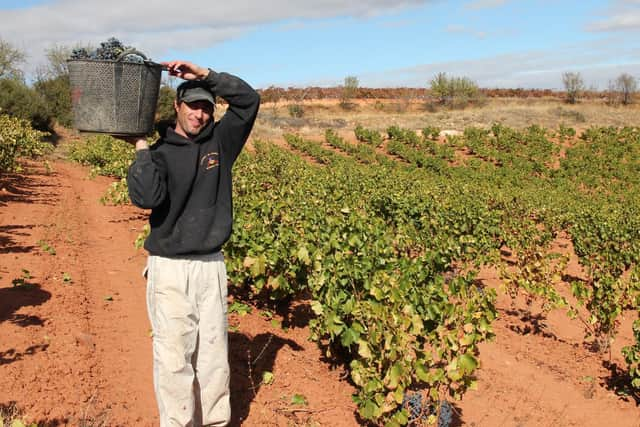Here are my top suggestions from The Wine Society’s latest offerings


But all that stopped some time ago, and tastings have taken a completely new approach. Instead, the wines come to me, usually a limited selection, either in full-sized bottles or in the fabulous little 100ml gas-flushed glass bottles that have now become common currency in home tastings.
So when The Wine Society said they wanted to send me some samples I was delighted but I did not expect the size of the parcel that arrived. There were eight long slender boxes, all taped together to make a huge, but lightweight parcel.
Advertisement
Hide AdAdvertisement
Hide AdIn typical efficiency, The Wine Society had put together six 100 ml bottles of wines from each of their eight buyers and then arranged a zoom call so that we could taste the wines together, asking questions along the way. It was one of the best-arranged tastings this year.


I only ever write about two wine clubs. One is The Yorkshire Post Wine Club, where I am involved in selecting the wines and the other is The Wine Society.
While we have a fabulous range of wine retailers in Yorkshire, supermarkets and independents, there are many people who like to join a club. There is something about the regular mailshots, the information, and in times gone by, the tastings that make choosing wine easy.
The Wine Society is a mail order wine club, but with important differences. It runs as a co-operative, so members must pay to join, but this gives you a share in the company. The dividend comes in the prices you pay for the wine which always offer great value for money. And your share doesn’t expire when you do. You can leave it to your nearest and dearest, confident that they will toast your departure with decent wine.
Advertisement
Hide AdAdvertisement
Hide AdSo having tasted through 48 of The Wine Society’s new and some established lines, here is my selection for your next order, all for spring into summer drinking. And while I am thinking of it, does anyone have ideas of what to do with 48 small, screw-topped glass bottles?
Whites
Familie Mantler Roter Veltliner, Niederösterreich, Austria, £8.95: Despite its name, Roter Veltliner is no relation to Grüner Veltliner. It is an almost-extinct, pinkish-white grape that makes wines with pear and peach notes, a rounded texture and a bright, lively citrus finish. I loved it.
Weissburgunder, Weingut Jülg 2019, Pfalz, Germany, £8.95: This is a new one for me. The grapes come from an estate that straddles the border between France and Germany, and so the grapes are from Alsace but under a long-standing protocol, the wine is sold as German. So essentially, this is an Alsace Pinot Blanc, with crisp apple and fresh peach notes with a zing of acidity and a rounded finish.
Lubanzi Chenin Blanc 2020, Swartland, South Africa £9.95 or £3.95 in a 250ml can: There is a story behind this brand, involving two American guys who started it all, links to extremely good winemakers as well as 50 per cent of profits going back into the South African community. And the wine is terrific. Ripe melon, pear and peach with a definite streak of lemon on the finish.
Advertisement
Hide AdAdvertisement
Hide AdJurançon Geyser, Domaine Cauhapé 2019, France, £11.50: This estate in the foothills of the Pyrenees is one of the most highly regarded in south-west France. Made from a handful of local grapes it has aromas of honeysuckle, citrus and a dash of herbs with a rounded, yet racy palate.
Camel Valley Bacchus, Cornwall, 2020 £13.95: If ever there was a year to drink English wine it is this one. Liven up your staycation with a taste of Cornish wine with the fresh, grapey flavours of the Bacchus grape, with elderflower and gooseberry notes alongside.
Rosé
Señorio de Sarria Rosado, Navarra 2020, Spain, £6.95: Rosés are now so delicate you have to look hard to see if they are white or pink. No confusion here, this is definitely rosé, and it has the flavour to prove it. 100% Garnacha, packed with raspberry and strawberry fruit and a bright, crisp finish.
Reds
Undurraga Candelabro Itata Cinsault 2019, Chile, £7.50 (available in May): This wine sold out when it first appeared in The Wine Society list. It comes from the deep south of Chile where temperatures are cooler. Packed with juicy red fruits, this can be chilled and poured Beaujolais-style with charcuterie, pizzas and salads.
Advertisement
Hide AdAdvertisement
Hide AdCh. Lary Tagot, Bordeaux 2018, France, £8.50: Exceptional value in this Merlot-dominated claret. It has a lift of green pepper on the aroma then leads into ripe, juicy, black fruits with just a hint of structure. Delicious now but will keep.
Beaujolais Les Pierres Dorées, Cuvée Louis Dépagneux 2020, France, £8.50: From the southern end of the Beaujolais region where golden limestone and warmer temperatures give the wines bigger, rounder flavours. This has strawberry and cherry fruit in abundance, with a bright finish.
Pauletts Polish Hill River Cabernet Sauvignon/Merlot 2017, Clare Valley, Australia, £11.50: The Clare Valley should be a lot warmer than it is, but there’s a breeze that rattles down the valley, keeping flavours fresh. It shows in this wine. Packed with blackberry and cassis notes, juicy and firm, with a streak of freshness on the finish.
Mancuso Garnacha, Carineña 2018, Spain, £12.95: Old vines, high altitude and expert wine making has produced a wine with floral aromas, blackberry and raspberry fruit on the palate with rounded easy tannins and a sense that this is a lot more serious than its price suggests. The winemaker is Jorge Nevascues who also makes the famous Contino wines in Rioja.
Advertisement
Hide AdAdvertisement
Hide AdThe Society’s Exhibition Rioja Reserva 2015, Spain, £16.50: The Exhibition range is essentially an up-market own label, sourced from top producers such as La Rioja Alta who make this wine. Slightly old-style Rioja with a traditional touch of oak, but with plenty of fruit keeping the balance. Gorgeous.